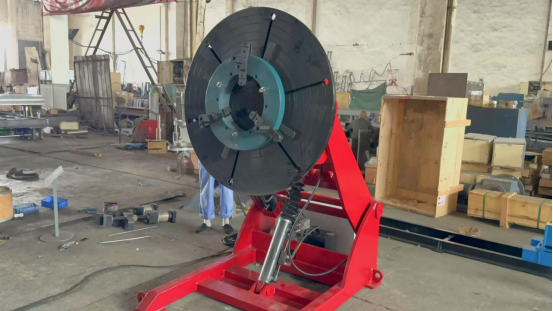In the manufacturing workshop of pressure vessels, Engineer Zhang faced a thorny challenge—an irregular head with a diameter of three meters required multiple circumferential welds at different angles. Four workers busily operated cranes, constantly adjusting the workpiece position. “This is the third time this month,” he said, pointing to the lack of fusion defects on the inspection report. “Manual flipping is not only inefficient but also makes it impossible to maintain consistent welding quality.”
This scenario plays out daily in the heavy manufacturing industry. As product structures become increasingly complex, multi-angle welding positioning has become the primary bottleneck restricting product quality and production efficiency. Traditional welding positioners typically only offer single-axis rotation, unable to meet the stringent demands of modern manufacturing for precision and flexibility.
3-Axis Positioner: Redefining Standards for Complex Workpiece Welding
The emergence of the 3-Axis Positioner provides a revolutionary solution to this industry challenge. This innovative equipment adopts a headstock-tailstock structure, achieving precise attitude adjustment of workpieces in space through coordinated movement in three degrees of freedom.
Compared to traditional equipment, the core advantages of intelligent 3-Axis Positioners are reflected in three aspects: ±130° large-angle tilting capability ensures welds are always in the ideal flat position; ±360° continuous rotation function enables welding without dead angles; the PLC control system ensures smooth synchronization of each axis’s movement, with positioning accuracy reaching ±0.1°.
Technological Breakthrough: From Fixed Position to Intelligent Positioning
At a heavy equipment manufacturing plant in Jiangsu, an intelligent 3-Axis Positioner system is operating smoothly. The operator inputs workpiece parameters via the touchscreen, and the equipment automatically calculates the optimal motion trajectory, completing a spatial curved weld that previously required multiple crane adjustments in a single pass.
“The breakthrough of this system lies in its intelligent algorithm,” explained the on-site technical manager. “By integrating a vision recognition system, the equipment can automatically identify weld seam positions and adjust workpiece attitude in real-time, reducing welding preparation time from 40 minutes to just 5 minutes.”
Measured data shows that after adopting the intelligent 3-Axis Positioner, the first-pass qualification rate for pressure vessel welding increased from 79% to 97.5%, the production cycle per unit shortened by 45%, and reducing rework alone saves over 1.8 million yuan annually.

Industry Applications: Comprehensive Innovation from Pressure Vessels to Engineering Machinery
The application value of intelligent 3-Axis Positioners has been validated across multiple heavy manufacturing sectors. In the chemical equipment field, it solves the multi-angle welding challenges of reactor agitator supports; in engineering machinery manufacturing, it provides perfect solutions for welding complex structural components of excavator booms; in the wind power sector, the accuracy of spatial curve welding for generator bases has significantly improved.
A production director from a heavy equipment manufacturing group stated: “We have deployed intelligent 3-Axis Positioner systems on five production lines. Not only has product quality stability greatly improved, but we’ve also achieved rapid changeovers for multi-specification products, increasing equipment utilization by over 60%.”
Selection Guide: How to Evaluate Intelligent 3-Axis Positioners
For companies considering equipment upgrades, evaluation is recommended from three dimensions: First, examine the system’s load capacity, paying attention not only to the rated load but also to stability under maximum partial load conditions. Second, focus on the intelligence level of the control system, including support for offline programming, process parameter storage, and equipment health management functions. Finally, verify the equipment’s accuracy retention, including the material and heat treatment process of key transmission components.
Equipment safety performance should not be overlooked. High-quality 3-Axis Positioners should possess multiple safety mechanisms such as dual limit protection, overload alarm, and emergency braking to ensure fail-safe processing of large workpieces.

Future Outlook: Intelligent Upgrade Development Directions
With the deepening application of Industry 4.0 technologies, intelligent 3-Axis Positioners are developing toward higher levels of intelligence. Digital twin technology enables real-time monitoring of equipment status and predictive maintenance; the application of 5G technology will further enhance the response speed and stability of equipment-robot collaboration; artificial intelligence algorithms can automatically optimize welding paths and process parameters based on historical data.
These technological innovations will not only promote the performance improvement of individual equipment but will also facilitate the intelligent transformation of entire production systems, providing solid support for the high-quality development of heavy manufacturing.
Conclusion: The Inevitable Choice for Investing in Smart Manufacturing
Against the backdrop of manufacturing transformation and upgrading, adopting intelligent 3-Axis Positioners is no longer simply equipment updating but an important strategic choice for enterprises to enhance core competitiveness and achieve sustainable development. For companies still struggling with complex workpiece welding quality, now is the perfect time to embrace technological innovation and move toward smart manufacturing.
